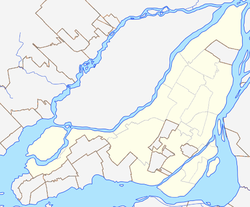
The National Film Board of Canada is Canada's public film and digital media producer and distributor. An agency of the Government of Canada, the NFB produces and distributes documentary films, animation, web documentaries, and alternative dramas. In total, the NFB has produced over 3,000 productions since its inception, which have won over 5,000 awards. The NFB reports to the Parliament of Canada through the Minister of Canadian Heritage. It has English-language and French-language production branches.

Norman McLaren, was a Scottish Canadian animator, director and producer known for his work for the National Film Board of Canada (NFB). He was a pioneer in a number of areas of animation and filmmaking, including hand-drawn animation, drawn-on-film animation, visual music, abstract film, pixilation and graphical sound.

Place des Arts is a major performing arts centre in Montreal, Quebec, Canada, and the largest cultural and artistic complex in Canada.

Place-des-Arts station is a Montreal Metro station in the borough of Ville-Marie, Montreal, Quebec, Canada. It is operated by the Société de transport de Montréal (STM) and serves the Green Line. The station opened on October 14, 1966, as part of the original network of the Metro.

The Quartier Latin is an area in the Ville-Marie borough of Montreal, located east of the Quartier des Spectacles and west of the Centre-Sud and Village, centred around UQAM and lower Saint-Denis Street. It is known for its theatres, artistic atmosphere, cafés, and boutiques. It owes its name, a reference to the Quartier Latin in Paris, to the presence of the École Polytechnique de Montréal and the nascent Université de Montréal in the 1920s. In the 1940s the university moved out and headed for a new campus on the north slopes of Mount Royal, far from the downtown borough. In the late 1960s UQAM was born and established itself in the Ville-Marie borough, giving a modern underpinning to the name. A large junior college, the CEGEP du Vieux-Montreal also moved in at about the same period.

Ville-Marie is the name of a borough (arrondissement) in the centre of Montreal, Quebec. The borough is named after Fort Ville-Marie, the French settlement that would later become Montreal, which was located within the present-day borough. Old Montreal is a National Historic Site of Canada.

Saint Laurent Boulevard also known as Saint Lawrence Boulevard is a major street in Montreal, Quebec, Canada. A commercial artery and cultural heritage site, the street runs north-south through the near-centre of city and is nicknamed The Main which is the abbreviation for "Main Street".

Saint-Catherine Street is the primary commercial artery of Downtown Montreal, Quebec, Canada. It crosses the central business district from west to east; beginning at the corner of Claremont Avenue and de Maisonneuve Boulevard in Westmount, and ending at the Grace Dart Extended Care Centre by Cadillac metro station. It also traverses Ville-Marie, passing just east of Viau in Mercier–Hochelaga-Maisonneuve. The street is 11.2 km long, and considered the backbone of Downtown Montreal.

Downtown Montreal is the central business district of Montreal, Quebec, Canada.
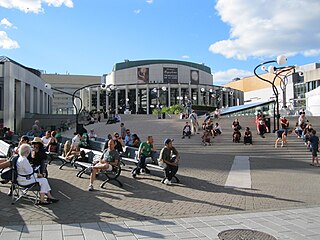
Salle Wilfrid-Pelletier is a large multipurpose venue in Montreal, Quebec equipped with sophisticated technical equipment. It seats 2,982 people and is part of the Place des Arts cultural complex in Montréal's Quartier des Spectacles entertainment district. It is the largest multipurpose stage in Canada.
Montreal was referred to as "Canada's Cultural Capital" by Monocle Magazine. The city is Canada's centre for French-language television productions, radio, theatre, film, multimedia and print publishing. The Quartier Latin is a neighbourhood crowded with cafés animated by this literary and musical activity. Montreal's many cultural communities have given it a distinct local culture.

The Musée d'art contemporain de Montréal (MACM) is a contemporary art museum in Montreal, Quebec, Canada. It is located on the Place des festivals in the Quartier des spectacles and is part of the Place des Arts complex.

Guy Street is a north-south street located in downtown Montreal, Quebec, Canada. Concordia University's Integrated Engineering, Computer Science and Visual Arts Complex is located on this street, as is the John Molson School of Business building. The street is home to the Guy-Concordia Metro station. Guy Street runs through the Little Burgundy and Shaughnessy Village neighbourhoods, and the recently named Quartier Concordia district, before changing to Côte-des-Neiges Road, above Sherbrooke Street.
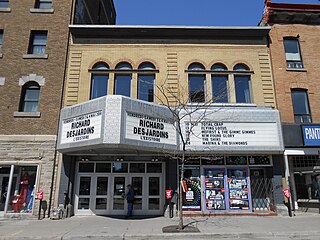
The M Telus is a performing arts centre in Montreal, Quebec, Canada. It is located in the central part of the city's downtown core, on Saint Catherine Street East between Saint-Dominique and De Bullion Streets, in the Quartier des Spectacles. The hall primarily features rock music groups, and is a venue for several festivals, including the Montreal International Jazz Festival and the Francofolies de Montréal.
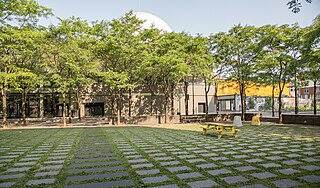
Peace Park or Place de la Paix is an urban square in Montreal. Peace Park is the colloquial name for Place de la Paix, which directly translates to "Place of Peace". Often, even in French newspapers, Place de la Paix is referred to as "Parc de la Paix". It is on Saint-Laurent Boulevard and, as such, it follows different by-laws than parks. For example, Peace Park is open to the public at all times, unlike parks with visiting hours.
Montréal 2025 is the modernization plan for the city of Montreal with innovative and avant-garde projects. Those include the Quartier des Spectacles and the Quartier de la Santé.
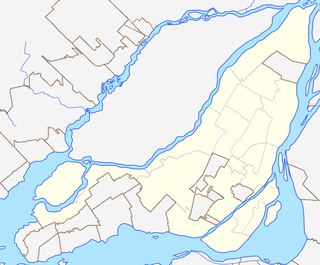
The Red-Light District of Montreal, Quebec, Canada was formerly centred on the intersection of Saint Laurent Boulevard and Saint Catherine Street in the borough of Ville-Marie.

Dare-Dare, stylized DARE-DARE, is an artist-run center and a nonprofit organization located in Montreal. It was founded by Sylvie Cotton and Claire Bourque. Its offices are located in a construction trailer, decorated by artists and stationed in different districts on the island of Montreal. The name given by the center to these successive temporary locations is Dis/location: urban articulation project.
Compagnons de Saint-Laurent is a theatre company that was founded in August 1937 at Collège de Saint-Laurent in Saint-Laurent, Quebec under the direction of Émile Legault at the insistence of Roger Varin, considered to be the co-founder. Léonide Lavinge is also considered a co-founder of the company. The company dissolved in 1951.
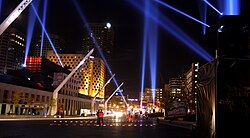


![Promenade des Artistes [fr]. FIJM 2013 - 125.jpg](http://upload.wikimedia.org/wikipedia/commons/thumb/8/86/FIJM_2013_-_125.jpg/330px-FIJM_2013_-_125.jpg)
